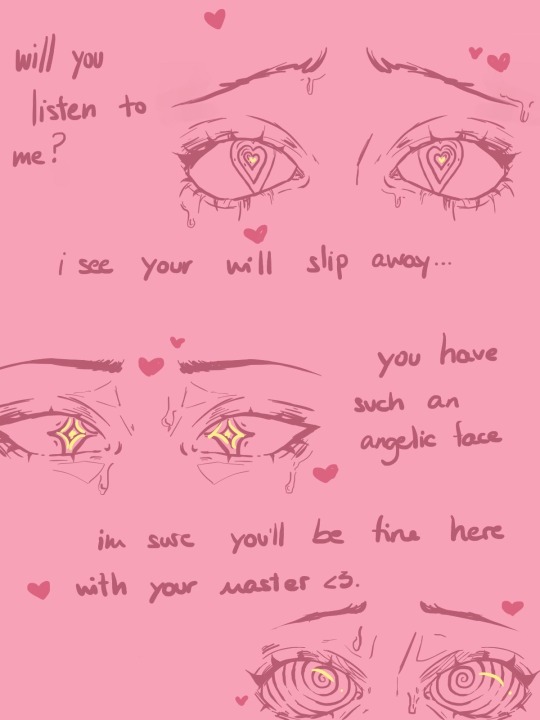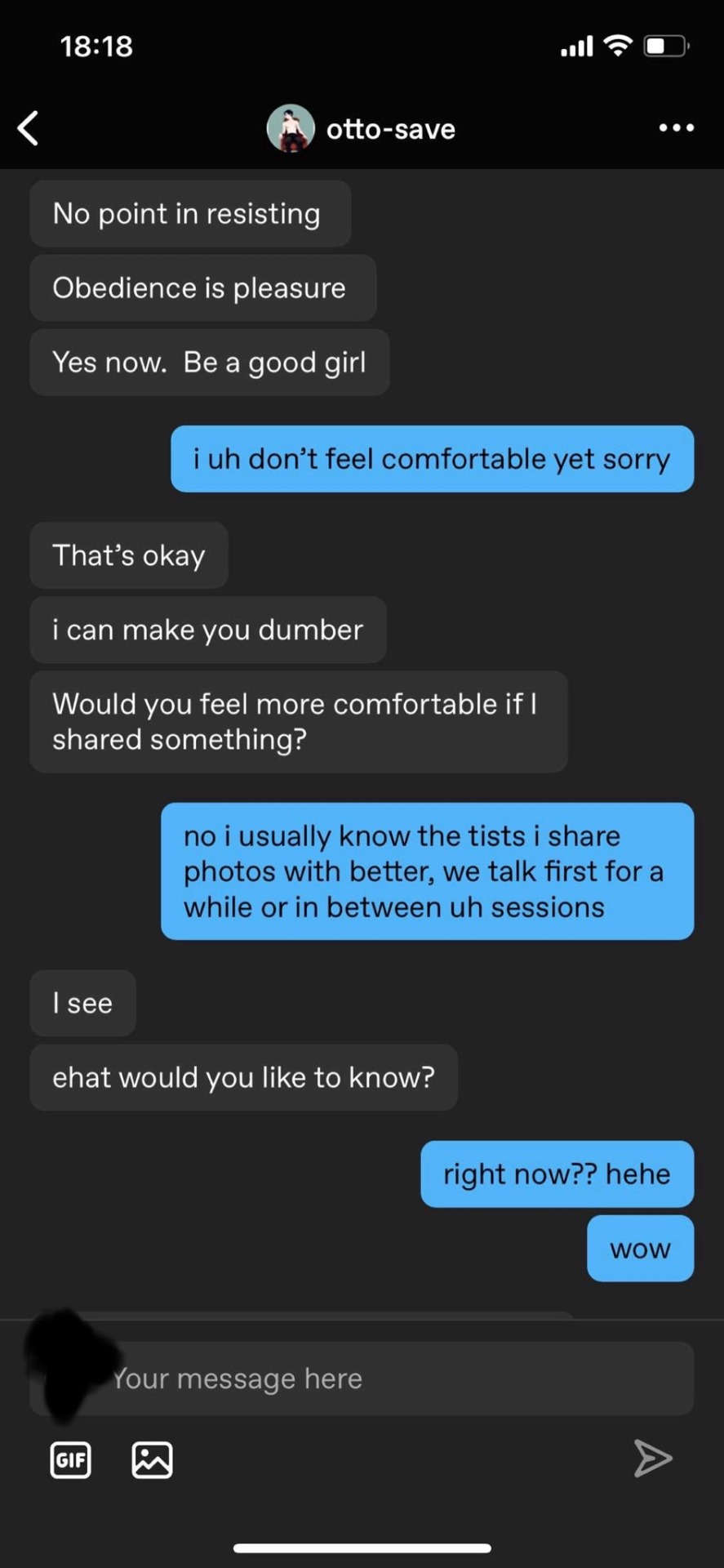#hypnokink community
Explore tagged Tumblr posts
Text

Bethany could only stand to attention and stare straight ahead. She desperately wanted to run but her body was no longer hers to control.
A soft moan escaped her mouth as she felt herself becoming overwhelmed with lust. She needed to cum, but she hadn’t been given permission yet. She didn’t know why that mattered but it did. She didn’t understand what had happened but she knew that she needed permission from her Master. Not just to cum, but to do anything.
She was so desperate now that she knew she would do anything she was told. All that mattered was obeying Master. She moaned louder.
#mind control#hypno pet#hypnosis#hypnosub#hypnokink community#hypnok1nk#hypno toy#hypno fantasy#hypnotic#hypnotized
566 notes
·
View notes
Text

old but never stopped being gold, i love doodling eyes <3
#hypnosis#digital drawing#digital illustration#hypno fantasy#hypnotic#hypno toy#hypnotism#hypnosub#hypnotist#hypnotized#eyes#glowing eyes#hypnokink community#digital commisions#commisions open#commissions open#commission#art commisions
931 notes
·
View notes
Text

Enter Mister-Sandman90, Yet another person who clearly lost their patience, and threw consent out of the window.
For what it's worth, stay safe out there hypno community. This is how messages start and how they could end.
Stop trying to hypnotize people without their consent. This shit is dangerous.
90 notes
·
View notes
Text
Send me Hypno
Any hypno audios/files/spirals that get sent to me I will consume and rate, please break my fragile mind
#hypno fantasy#hypno k1nk#hypno k!nk#hypnofetish#hypnosis#hypnotized#hypnosub#hypnosis community#hypnokink community
26 notes
·
View notes
Text
about me +*:ꔫ:*﹤
my name is kallia (she/they) and i am 24. this blog contains some darker kinks, so please read this first and continue at your own risk. i do not condone any illegal or immoral acts–everything here is simply fantasy, a collage of the dirty thoughts and feelings that i yearn to express.
i am a bi/pan bratty switch–i am needy and just can’t get enough! as a Domme, i love being called Mommy, Daddy, and Mistress. those titles are earned, so you may call me Miss, Goddess, and Queen. i’m more on the caring/nurturing side with a strong sadistic streak.
as a sub, i like being a little girl (usually playing 6-12). my favourite pet names are kitten, baby girl, princess, and angel. call me whatever you want... feel free to use degrading names too. i am a big masochist and love leaning into the intensity of everything. i love crying and making people cry, both from physical and emotional pain. BDSM is a big part of my life and to me is a spiritual experience.
my asks are always open (i prefer those to DMs). i love receiving horny messages, threats, prompts and requests... but i also just love making friends and having sexual conversations and/or intellectual discussions about kink.
i loveeee writing and i loveeee audios. i love all the theatrics. the teasing, the slow burn, the passion, the yearning.
my original posts are tagged #bratprincesskitten
kinks and limits/dni are listed below.
bdsm test results:
100% switch
100% brat and brat tamer
100% degradee and degrader
100% sadist and masochist
100% little
100% daddy/mommy
100% voyeur and exhibitionist
96% submissive
93% dominant
86% master/mistress
75% owner
68% pet
47% slave
some favourite kinks:
CNC, DD/lg, MD/lb, MD/lg, BDSM, ageplay, incest, power exchange, pain, intox, somno, breeding, orgasm control, edging, gooning, denial, hypno, corruption, brainwashing, cum, humiliation/degradation, praise, public, bondage, anal, group play, sensory play, sensuality/eroticism, and so much more (if it's not listed on my limits i am probably open to it)
limits:
scat, vomit, hardcore gore, extreme violence, permanent damage, raceplay, hardcore misogyny, feederism, ana/fatphobic content, showing my face, people entitled to my content or my time
do not interact if:
you’re a minor, a pedo, a real predator/rapist, racist, homophobic, transphobic, misogynistic, all the usual stuff.
26 notes
·
View notes
Text

Cassidy had no idea how long she had been standing there. Time seemed to have stopped for her. Her breathing was calm and slow, but her nipples were rock hard and her pussy dripping. She really, really needed to obey someone right now. But whom?
#mind control#hypnosis#hypnokink community#hypnosub#hypno pet#hypno toy#hypno fantasy#hypnok1nk#hypnotized#spirals#spiral#obedient
482 notes
·
View notes
Text

a rendering warm up in between studying. in two days i’ll finally be free!! expect more things then hahah <3
.
.
#hypnosis#digital drawing#digital illustration#hypnotic#hypno fantasy#hypno toy#hypnotism#hypnosub#hypnotist#hypnotized#hypnokink community#digital commisions#commisions open#commissions open
12 notes
·
View notes
Text
sitting all alone in my room desperately rubbing between my thighs while scrolling through tumblr. Kinda lonely tbh :( ((threats are welcome, pretty please!))
19 notes
·
View notes
Text
@otto-save consent violator. Be careful, hypnokinksters.



"being dumb and mindless doesn't suddenly shift my limits."
If I'm working with anybody you all see on my page, assume that I've warned them already about individuals like this.
107 notes
·
View notes
Text
Another Hypno Review
8/10, I'm a sucker for text based inductions and this one is great, the spirals are fantastic, not much else to say other than all around this is a good script
#hypno fantasy#hypno k1nk#hypnofetish#hypno k!nk#deeply hypnotized#hypnosis community#hypnosub#hypnotised#hypnotized#hypnosis#hypnokink community
12 notes
·
View notes
Text

‘DROP DEEP NOW’ read the text message. It was followed by a swirling pink spiral and Eloise’s mind immediately dropped, the trigger having already taken deep root in her psyche ever since Master installed it a week ago.
‘You have been a good girl for Master, Eloise. Well done installing the subliminal programming on your friends’ phones. I am going to activate them soon and you will all join me at my house for further programming. Once you have read this message you will delete it, both from your phone and from your conscious mind and you will awaken with no memory of receiving this text. You will receive further instructions soon.’
Eloise finished reading and her eyes regained their focus as she deleted the text and briefly wondered why she was looking at her phone. Shaking her head she put it away and went on with her day, not even noticing the drying drool on her chin.
#mind control#hypno pet#hypnosis#hypnosub#hypnokink community#hypno fantasy#hypno toy#hypnok1nk#spirals#obedient
344 notes
·
View notes
Note
what is your deepest darkest sexual fantasy?
probably getting hypnotized against my will and edged/overstimmed for long periods of time, that’s just me though !!
11 notes
·
View notes
Text
🤣



🤣


This is the stupidity that ruins the community.
Thirsty ass hypno rapists.
I know I have my fair share of people that don’t fuck with me for whatever the reason. Could be genuine dislike, jealousy, or all of the above. But consent matters no matter what.
It’s honestly comical at this point. Some of y’all, like these two dumb asses, really think that hypnosis works like this. And that’s because for a few, it does. There are some very susceptible subjects out here who run into the wrong tist who fails to educate them about the dangers of hypnosis and how serious you should take the responsibility of performing hypnosis.
…And then there’s the people I work with.
They see you.
They get this all the time.
I tag them in my post so they can see when they go up. I used to tag them so they could hopefully meet some cool people in the community and branch out. I don’t have any horror stories yet so far, but I do have screenshots of this dumb ass activity over the years.
I do train them to watch themselves.
I let them know the accounts that do this.
I let them know what to watch out for because I know all people like this are gonna do is delete and make new accounts when shit gets too hot for them.
Pass this around. Have em do it again. Lol.
Thank you for reading.
42 notes
·
View notes
Text
See you at Charmed! I'm the brown, big, soft spoken older male you missed the first time around. You can call me Cee. 🌀
@charmedhypno
11 notes
·
View notes
Text
Hi everyone, I'm Dante.
I'm from Australia, though I'm travelling a lot back and forth between Canada and Aus.
I'm a straight, Cis Male, mainly a sub leaning switch, but I'm looking to improve my Hypno skills, and would love to practice with people, provided of course that the rapport is there. Beyond that, I do enjoy subbing to people I know and trust, and my reblogged stuff obviously reflects that, lol.
I'm relatively inexperienced, mainly just because it's taken me a while to grow into someone who can have this type of experience openly, lol.
I've had an interest in EH for maybe close to 12 years, but only started exploring it properly it 2022, and I've enjoyed every second of it so far.
If that interests anyone, you can ask me about it 🙂
2 notes
·
View notes
Text

Sarah couldn’t remember opening the email. In fact she couldn’t remember much of anything. All she knew was that she must obey her Master.
344 notes
·
View notes